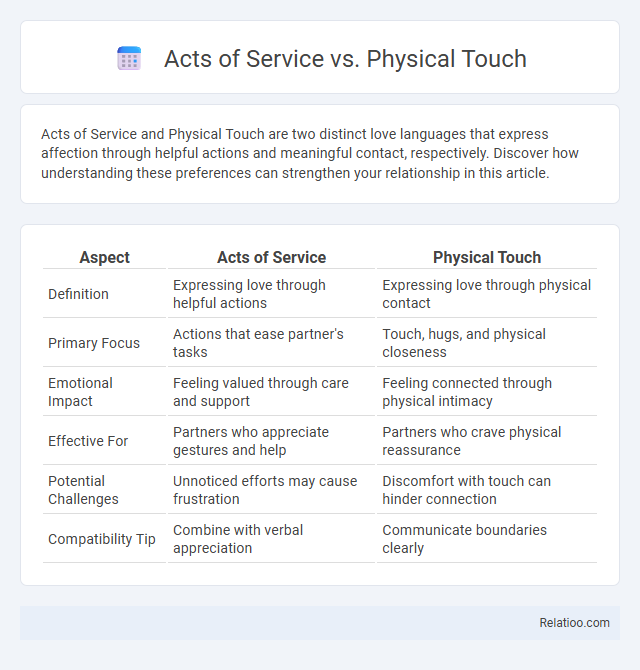Acts of Service and Physical Touch are two distinct love languages that express affection through helpful actions and meaningful contact, respectively. Discover how understanding these preferences can strengthen your relationship in this article.
Table of Comparison
| Aspect | Acts of Service | Physical Touch |
|---|---|---|
| Definition | Expressing love through helpful actions | Expressing love through physical contact |
| Primary Focus | Actions that ease partner's tasks | Touch, hugs, and physical closeness |
| Emotional Impact | Feeling valued through care and support | Feeling connected through physical intimacy |
| Effective For | Partners who appreciate gestures and help | Partners who crave physical reassurance |
| Potential Challenges | Unnoticed efforts may cause frustration | Discomfort with touch can hinder connection |
| Compatibility Tip | Combine with verbal appreciation | Communicate boundaries clearly |
Understanding Acts of Service and Physical Touch
Understanding Acts of Service and Physical Touch as primary love languages reveals how individuals express and experience affection differently. Acts of Service involve demonstrating love through helpful actions and thoughtful gestures that ease a partner's burden, while Physical Touch emphasizes the importance of physical presence and tactile connection such as hugs, holding hands, or gentle touches. Recognizing these distinct expressions enhances communication and strengthens emotional intimacy within relationships.
Defining Love Languages: Core Differences
Acts of Service, Physical Touch, and other love languages represent distinct ways individuals express and receive affection, crucial for understanding relationship dynamics. Acts of Service emphasize actions and helpful deeds as expressions of love, while Physical Touch centers on closeness through affectionate contact, such as hugs or hand-holding, to convey emotional connection. Recognizing Your primary love language can enhance communication and deepen intimacy by aligning how You express love with how Your partner best receives it.
The Psychology Behind Acts of Service
Acts of Service as a love language reflect deep psychological motivations rooted in the desire to feel helpful and valued through tangible actions, signaling care and commitment. This form of expression activates reward centers in the brain associated with caregiving, promoting emotional bonding and trust between partners. Understanding the psychology behind Acts of Service reveals how intentional acts, such as chores or favors, fulfill emotional needs by demonstrating reliability and support in relationships.
The Emotional Impact of Physical Touch
Physical Touch as a love language deeply influences emotional well-being by fostering feelings of safety, comfort, and connection through physical closeness. Acts such as hugging, holding hands, and gentle touches release oxytocin, a hormone that reduces stress and strengthens emotional bonds. Unlike Acts of Service, which express love through helpful actions, Physical Touch uniquely provides immediate emotional reassurance and intimacy.
Signs That Acts of Service Is Your Love Language
Signs that Acts of Service is your love language include feeling deeply appreciated when your partner helps with chores or takes initiative in daily tasks without being asked. You experience a strong emotional connection when actions like cooking a meal, running errands, or fixing things are done for you, reflecting care and commitment. Unlike Physical Touch, which relies on physical closeness, Acts of Service communicates love through practical support and thoughtful deeds that make your life easier.
Recognizing Physical Touch in Relationships
Recognizing physical touch as a primary love language involves understanding nonverbal cues such as holding hands, hugging, or gentle touches that convey affection and emotional connection. Physical touch strengthens intimacy and fosters a sense of security, playing a vital role in relationship satisfaction according to Dr. Gary Chapman's love language theory. Couples who prioritize physical touch often experience increased trust and bonding, making it essential to acknowledge and respect each partner's comfort level with physical contact.
Acts of Service vs Physical Touch: Pros and Cons
Acts of Service demonstrate love through helpful actions, providing practical support that strengthens relationship reliability but may require time and effort, sometimes leading to imbalance if not reciprocated. Physical Touch conveys affection through hugs, kisses, or hand-holding, fostering emotional closeness and reducing stress hormones but can be misinterpreted or uncomfortable without proper consent. Both love languages cater to different emotional needs, with Acts of Service appealing to those valuing thoughtful deeds and Physical Touch resonating with individuals seeking direct, sensory connection.
Navigating Miscommunication in Love Languages
Misunderstandings often arise when Acts of Service and Physical Touch are expressed without recognizing your partner's primary love language, leading to feelings of neglect despite good intentions. Clear communication about each other's preferred love language helps prevent miscommunication and fosters deeper emotional connection. Prioritizing your partner's love language encourages meaningful exchanges and reduces frustration, strengthening your relationship bond.
Balancing Both Love Languages in Partnerships
Balancing Acts of Service and Physical Touch in relationships enhances emotional connection by catering to your partner's unique love language needs. Prioritizing consistent actions of support while integrating affectionate physical gestures fosters mutual understanding and strengthens partnership bonds. Recognizing and respecting these complementary expressions enables a deeper, more fulfilling love experience for both individuals.
Tips for Meeting Each Other’s Love Language Needs
Understanding Acts of Service as a love language involves performing helpful tasks to express care, while Physical Touch emphasizes affectionate gestures like hugs and hand-holding to convey love. Couples can meet each other's needs by identifying specific actions that resonate, such as preparing a meal or offering comforting embraces, ensuring consistent efforts align with their partner's preferred love language. Effective communication about these preferences improves emotional connection and fosters deeper intimacy between partners.

Infographic: Acts of Service vs Physical Touch
 relatioo.com
relatioo.com